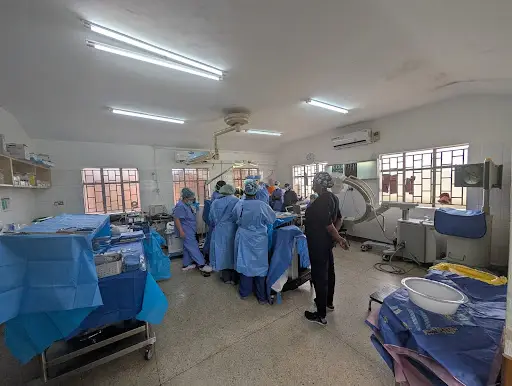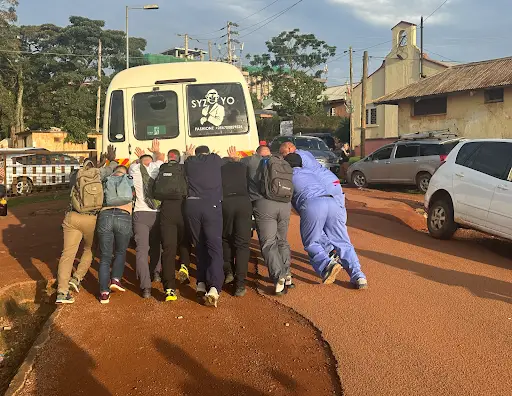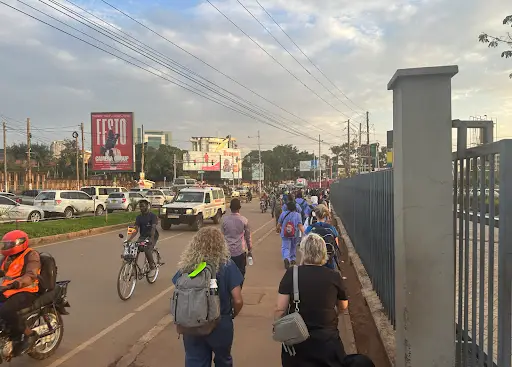Day 3-4:
Day 3
We arrived at 7:30 a.m. and hit the ground running. Since we’re the second team of this mission, many of the supplies were already unpacked and organized by Team 1 in the main library—our home base for the week.

The moment the team arrived in the core and started unpacking!
With everything ready, we planned to operate on day one.
The team quickly divided into three groups:
- One group stayed in the library (“the core”) to take inventory and further organize supplies.
- A second group, led by Dr. Lieberman, headed to the OR to begin prepping for the day’s only case.
- The third group went to the spine ward to begin patient rounds and evaluate the inpatient population.
Thanks to prior communication with Team 1, we had a general idea of the patients we would encounter—but we still ended up seeing nearly 40 patients throughout the day.
While rounds were underway, Dr. Lieberman’s team began our first case: a 17-year-old girl with infectious TB spondylodiskitis, a serious spinal infection that involves both the vertebrae and the intervertebral discs. Her surgery involved a posterior spinal fusion and a T8–T9 corpectomy with interbody fusion.

Dr. Lieberman and the team starting our first operation of the trip!
As the case carried on throughout the day, so did the patient intake process. Unlike last year, in which we took pictures of each individual scan, Stanley, who had been there the week prior, emphasized to the patients the importance of getting a CD that contained their full MRI and CT scans. Because of this, we were able to store and organize patients’ files electronically and in an easy-to-access to access fashion.
By the end of the day, the rounds team regrouped in the core, where we wrapped up organization and debriefed. Dr. Lieberman’s team finished the case successfully, and like that, our first day was in the books.
All in all, it was a strong start to the week. With a full operative schedule ahead and a clearer sense of the workload, the team was prepared to handle whatever lay ahead.
Day 4
This morning was another of many beautiful mornings, highlighted by a very colorful sunrise. Like normal, we left for the hospital at 7:15 a.m. and, surprisingly, encountered almost no traffic, which is a rarity in such a busy city. We arrived at the hospital at 7:35 and sprang right into action.
The team immediately began setting up the core for the day’s cases while also prepping the lecture room for our first lecture of the week, given by Dr. Lieberman. The topic was: Recognition and Management of Adolescent Idiopathic Scoliosis.

Dr. Lieberman answering questions after his morning presentation.
Today was our first day taking on multiple cases. One of the biggest issues that team 1 reported facing, and that we saw last year, was a very long delay between arriving at the hospital and making the first incision. So, after the morning teaching session, we all got right to work.
- Dr. Lieberman’s group prepped and began their first and only case of the day in the Spine Theatre, a T12-L4 PSF and L2 Decompression.
- Dr. Hisey’s team prepared their first case of the trip in Ward 7: a posterior laminectomy and decompression + deroofing of L1/L3.
- The rounds team continued working on patient evaluations in the spine ward.
I was part of the team conducting ward rounds that morning, and things quickly became hectic. We began at the first patient’s bed with a group of about five—Dr. Hisey, Stanley, Jennifer Shivers, one of the Ugandan residents, and I. But as we moved from patient to patient, the group steadily grew. By the time we reached the fifth or sixth bed, there were a dozen people crowding into tight spaces, making it hard to hear or communicate effectively. Given the chaos and speed we were working at, Stanley and I decided to go back through the ward afterward—repeating the rounds thoroughly, documenting each patient in detail, and standardizing our notes to ensure that we had clarity and consistency in our notes.

The chaos of the morning rounds.
By midday, both surgeries were successfully completed, and Stanley and I were satisfied with the patient database that we had created.
Originally, we had another case scheduled for today, but the team had to quickly adapt when the patient’s blood pressure unexpectedly shot up, causing us to have to unfortunately cancel the operation as it was no longer safe to operate.
So, as we closed out the day, Stanley and I worked to reorganize the schedule and reassign the cases for the week.
As we wrapped up for the day, one final twist came our way: the bus broke down. After trying (and failing) to push-start it uphill, the team ditched the vehicle and walked the 4 km back to the hotel through rush hour. Instead of complaints, the walk turned into a highlight—giving us a new way to see the city and a great moment to share as a team.


The team attempting to give the bus a push start before ultimately deciding to walk back to our hotel through rush hour traffic!

